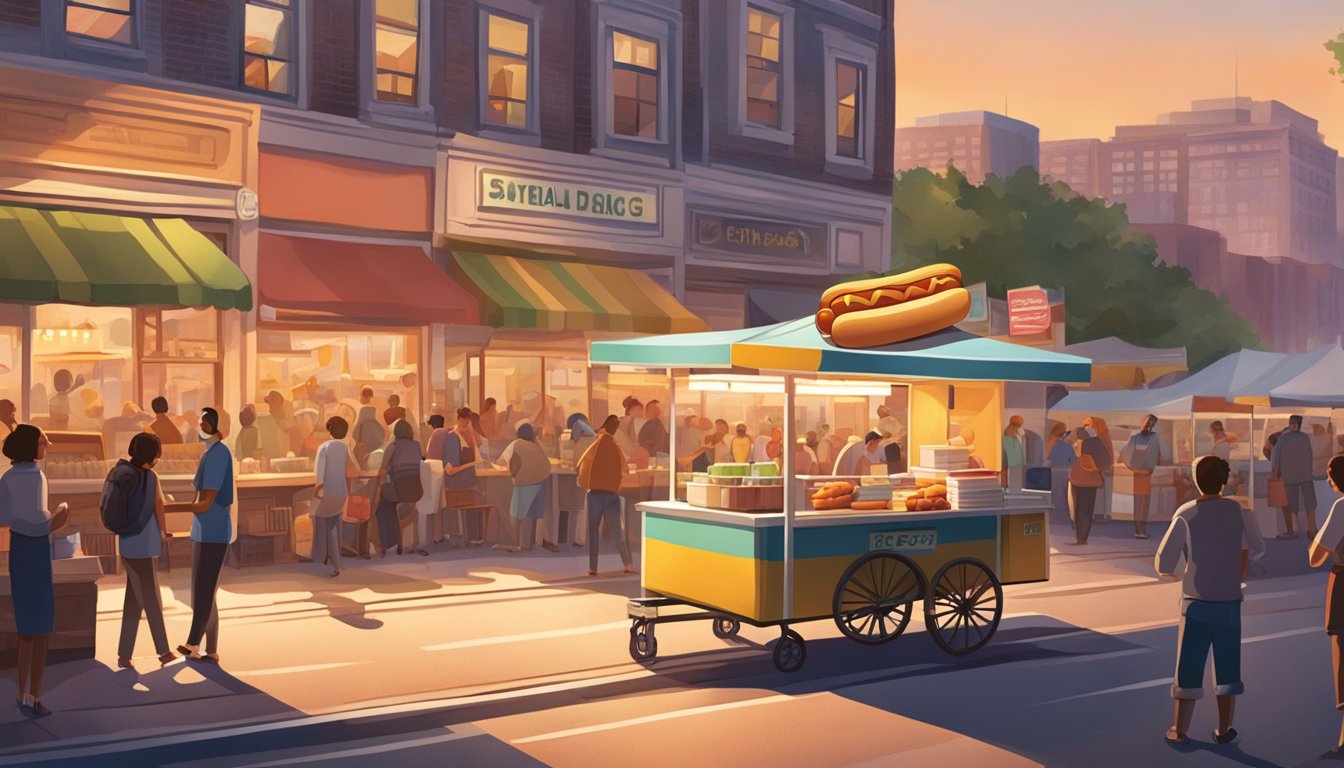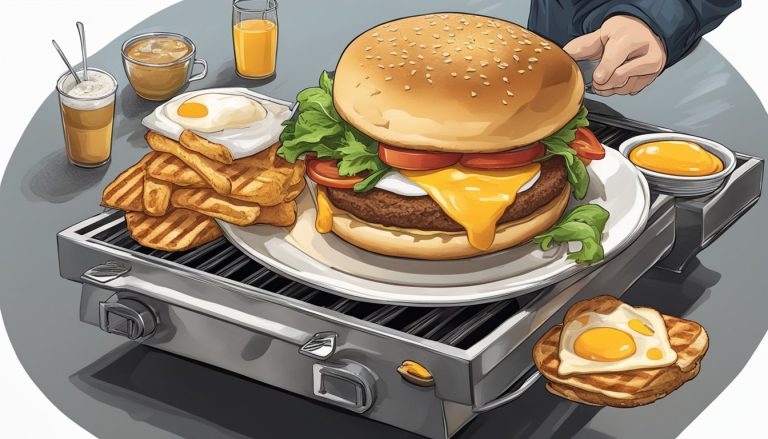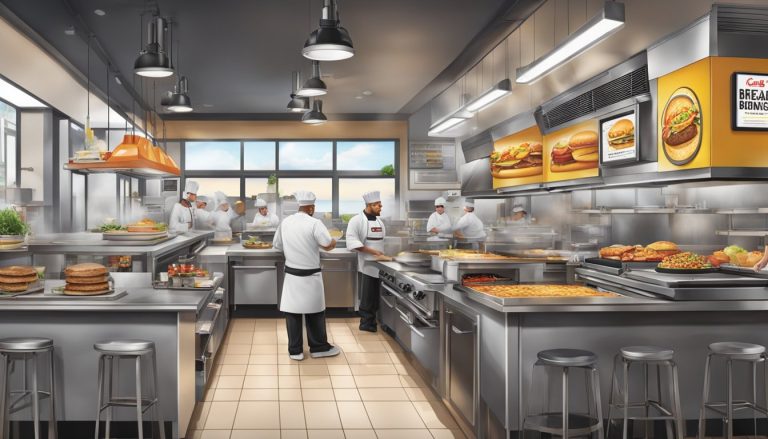Carl’s Jr., a well-known fast-food chain, traces its humble beginnings to a single hot dog cart in California. In 1941, Carl Karcher and his wife invested $15 of their savings and borrowed $311 to purchase a hot dog cart in Los Angeles. This modest start would eventually grow into a breakfast empire with over 1,000 restaurants across the United States.
The Karchers’ initial venture proved successful, leading them to expand to multiple hot dog stands within a few years. In 1945, they opened their first full-service restaurant, Carl’s Drive-In BBQ, in Anaheim. The transition from hot dogs to hamburgers came in 1956 when the first Carl’s Jr. restaurant opened its doors.
Carl’s Jr. gained popularity for its innovative menu items and focus on quality ingredients. The chain expanded its offerings over the years, becoming particularly known for its breakfast options. Today, Carl’s Jr. stands as a testament to the power of entrepreneurship and the American dream, having evolved from a simple hot dog cart to a major player in the fast-food industry.
The Founder’s Early Life

Carl N. Karcher’s journey from a small-town Ohio farm boy to fast-food mogul exemplifies the American Dream. His early experiences and bold move to California laid the foundation for his future success.
Carl N. Karcher’s Origins
Carl N. Karcher was born on January 16, 1917, in Upper Sandusky, Ohio. He grew up on his family’s farm, where he learned the value of hard work and perseverance. As one of eight children, Carl developed a strong sense of responsibility from a young age.
The Karcher family faced economic challenges during the Great Depression. This period shaped Carl’s character and instilled in him a desire for financial stability. He left school after eighth grade to help support his family, working various jobs including delivering bread.
Move to Southern California
In 1937, at the age of 20, Carl made a life-changing decision. He moved to Anaheim, California, to live with his uncle. This bold step marked the beginning of his entrepreneurial journey.
Initially, Carl worked at his uncle’s feed and seed store. He then took a job as a bread delivery man for a bakery. This experience exposed him to the food service industry and sparked his interest in business.
Carl’s move to Southern California proved pivotal. The region’s growing population and economic opportunities provided fertile ground for his future ventures. It was here that he would later establish his first hot dog cart, setting the stage for the Carl’s Jr. empire.
The First Venture

Carl Karcher’s journey into fast food began with a humble hot dog cart in 1941. This small investment quickly grew into multiple stands and eventually led to the opening of Carl’s Drive-In Barbecue.
From Hot Dog Stand to a Hot Dog Cart
On July 17, 1941, Carl and Margaret Karcher invested $326 in a hot dog cart. They used $15 from their savings and borrowed $311 against their 1941 Plymouth Super Deluxe. The cart was set up in Los Angeles, selling hot dogs and tamales.
The first day’s sales totaled $14.75, equivalent to about $140 today. Despite this modest start, the business showed promise. Carl’s commitment to quality and customer service helped the venture grow rapidly.
Expansion into Carl’s Drive-In Barbecue
Within a few years, the Karchers expanded to three more hot dog stands. Their success in Orange County led to a significant leap forward. On January 16, 1945, Carl’s 28th birthday, they opened Carl’s Drive-In Barbecue in Anaheim.
This full-service restaurant marked a turning point. It offered a broader menu, including barbecue items and chili dogs. The drive-in concept catered to the growing car culture in Southern California.
Carl’s Drive-In Barbecue became the foundation for future expansion. It established Karcher as a serious player in the fast food industry and set the stage for the creation of Carl’s Jr. in 1956.
The Rise of Carl’s Jr.

Carl’s Jr. rapidly expanded from a single hot dog cart into a major fast food chain known for its innovative menu items and bold branding. The company’s growth was driven by a focus on convenience and quality burgers.
Establishing the Restaurant Chain
Carl Karcher opened the first Carl’s Jr. restaurant in 1956 in Anaheim, California. The smaller, quick-service concept was a scaled-down version of his full-service Carl’s Drive-In Barbecue. Carl’s Jr. locations featured a streamlined menu centered on burgers, fries, and soft drinks.
The chain expanded across California in the 1960s and 1970s. By 1980, there were over 300 Carl’s Jr. restaurants. The company went public in 1981 as Carl Karcher Enterprises, fueling further growth.
Carl’s Jr. differentiated itself with larger, higher-quality burgers than most fast food competitors. The Famous Star burger became its signature item.
Innovation and Branding
In the 1980s and 1990s, Carl’s Jr. introduced several menu innovations that boosted its popularity. The Western Bacon Cheeseburger debuted in 1981, featuring bacon, barbecue sauce, and onion rings.
The Six Dollar Burger launched in 2001, bringing sit-down restaurant quality to fast food. This premium burger line expanded to include varieties like the Thickburger.
Carl’s Jr. adopted edgy marketing in the 2000s, with provocative ads featuring celebrities and models. The star logo and “Don’t Bother Me. I’m Eating.” slogan became instantly recognizable.
By 2025, Carl’s Jr. had grown into a global burger empire with over 1,000 locations across the Americas, Asia, and beyond.
Corporate Growth and Challenges

Carl’s Jr. experienced rapid expansion but faced significant hurdles along the way. The company’s growth led to structural changes and acquisitions, while legal and ethical issues posed challenges for its leadership.
Formation of CKE Restaurants
Carl Karcher Enterprises went public in 1981, fueling further expansion. In 1997, the company acquired Hardee’s, forming CKE Restaurants. This move expanded Carl’s Jr.’s presence eastward and diversified its portfolio.
CKE Restaurants focused on upgrading Hardee’s locations and menu offerings. The company implemented a dual-branding strategy, introducing Carl’s Jr. menu items at Hardee’s restaurants.
By the early 2000s, CKE Restaurants operated over 3,000 locations across the United States and internationally.
Controversies and Legal Battles
Carl Karcher faced legal troubles in the 1980s. The Securities and Exchange Commission charged him with insider trading in 1988. Karcher allegedly tipped off family members about a decline in company earnings.
He settled the case without admitting guilt but paid $664,000 in fines.
In 1978, Karcher publicly supported Proposition 6, a California initiative to ban gay teachers from public schools. This stance led to boycotts of Carl’s Jr. restaurants.
The company also faced criticism for its advertising campaigns, which some deemed too sexually suggestive. These controversies impacted the brand’s image and sales in certain markets.
Menu Innovations and Collaborations

Carl’s Jr. has continuously evolved its menu and partnered with other brands to stay competitive in the fast food industry. These efforts have expanded their offerings beyond burgers to appeal to a wider range of customers.
Diverse Culinary Offerings
Carl’s Jr. introduced Six Dollar Burgers in 2001, featuring premium ingredients at fast food prices. The chain added salad bars to many locations in the 1980s to attract health-conscious diners. Breakfast items like Made from Scratch Biscuits became menu staples in 1978.
Carl’s Jr. ventured into Mexican cuisine through its Green Burrito concept. This dual-branding strategy allowed the chain to offer tacos, burritos, and quesadillas alongside its traditional burgers and fries.
The company has experimented with limited-time offerings to generate buzz and attract new customers. These have included innovative burger toppings, unique sandwich combinations, and seasonal desserts.
Partnerships with Other Brands
Carl’s Jr. has collaborated with well-known brands to create unique menu items. A notable partnership was with KFC, where some Carl’s Jr. locations offered KFC’s fried chicken alongside their burgers.
The merger with Hardee’s in 1997 led to menu cross-pollination between the two chains. Popular items from each brand were introduced to the other, expanding regional favorites to new markets.
Carl’s Jr. has also partnered with snack and condiment brands to create limited-time burgers and sides. These collaborations have helped the chain stay relevant and appeal to younger demographics seeking novel food experiences.
Cultural Impact and Marketing

Carl’s Jr. has left an indelible mark on American fast food culture through its bold marketing and unique positioning. The brand’s advertising and competitive strategies have helped it carve out a distinct identity in a crowded market.
Advertising Strategies
Carl’s Jr.’s provocative ad campaigns have garnered significant attention. The brand became known for its racy commercials featuring celebrities and models. These ads often sparked controversy but succeeded in generating buzz.
Carl’s Jr. embraced social media marketing early on. They leveraged platforms like Twitter and Instagram to engage younger audiences. The company’s social media presence helped maintain relevance in a changing media landscape.
More recently, Carl’s Jr. has shifted towards emphasizing food quality and innovation. They’ve highlighted menu items like their 100% Angus beef burgers and hand-breaded chicken tenders. This approach aims to appeal to health-conscious consumers seeking higher quality fast food options.
Comparison with Competitors
Carl’s Jr. differentiates itself from competitors like McDonald’s through its focus on larger, more indulgent burgers. While McDonald’s targets a broader audience, Carl’s Jr. aims for a more specific demographic of young, hungry males.
The brand’s menu innovation sets it apart. Carl’s Jr. regularly introduces bold new items, such as their Beyond Meat plant-based burgers. This contrasts with more conservative menu strategies of some competitors.
Carl’s Jr.’s breakfast offerings, including their Made from Scratch Biscuits, compete directly with other chains’ morning menus. Their emphasis on freshness and quality in the breakfast category has helped establish a loyal morning customer base.
Philanthropy and Social Responsibility

Carl Karcher and Carl’s Jr. engaged in various philanthropic efforts and took stances on social issues. Their charitable work focused on local communities and causes aligned with Karcher’s values.
Philanthropic Ventures
Carl Karcher supported numerous charitable organizations throughout his life. He made significant contributions to the United Way of Orange County, helping fund programs for those in need. Karcher also donated to the Orangewood Children’s Home, providing resources for abused and neglected children.
The Carl’s Jr. founder supported Catholic charities and was a member of the Knights of Malta, a Catholic lay religious order. His faith-based giving extended to various Catholic educational institutions and hospitals.
Carl’s Jr. established corporate giving programs, encouraging employees to volunteer and donate to local causes. The company partnered with youth organizations to provide job training and employment opportunities for young people.
Political and Social Causes
Carl Karcher was known for his conservative political views and support of right-wing causes. He donated to the Right to Life League, reflecting his strong pro-life stance. Karcher also backed conservative political candidates who aligned with his values.
His views sometimes led to controversy, particularly regarding LGBT rights. Karcher faced criticism for his opposition to gay rights initiatives in California during the 1970s and 1980s.
Despite the controversies, Karcher supported some non-partisan cultural institutions. He donated to the South Coast Repertory, a Tony Award-winning theater company in Costa Mesa, California, showcasing his appreciation for the arts.
Legacy and the American Dream

Carl Karcher’s journey from a hot dog cart to a fast food empire embodies the American Dream. His story of hard work, innovation, and perseverance continues to inspire entrepreneurs and shape the industry.
Impact on Fast Food Culture
Carl’s Jr. revolutionized fast food with its focus on quality and innovation. The chain introduced the first char-broiled hamburgers and pioneered the drive-thru concept. These innovations set new standards for speed and convenience in the industry.
Carl’s Jr. also expanded the fast food menu beyond burgers. The company was among the first to offer salad bars and breakfast items, catering to changing consumer preferences.
The acquisition of Hardee’s in 1997 further solidified Carl’s Jr.’s position in the market. This move expanded the brand’s reach and introduced its star logo to a wider audience.
The Enduring Vision
Carl Karcher’s vision of serving quality food quickly and affordably continues to guide Carl’s Jr. The company maintains its commitment to innovation, regularly introducing new menu items and concepts.
Carl’s Jr. has expanded internationally, bringing its signature offerings to over 40 countries. This global presence showcases the enduring appeal of Karcher’s original vision.
The brand’s success story serves as a testament to the power of entrepreneurship. It demonstrates how a small business can grow into a multinational corporation through dedication and adaptability.
Carl Karcher’s legacy extends beyond his company. His philanthropic efforts and commitment to community service set an example for corporate responsibility in the fast food industry.




